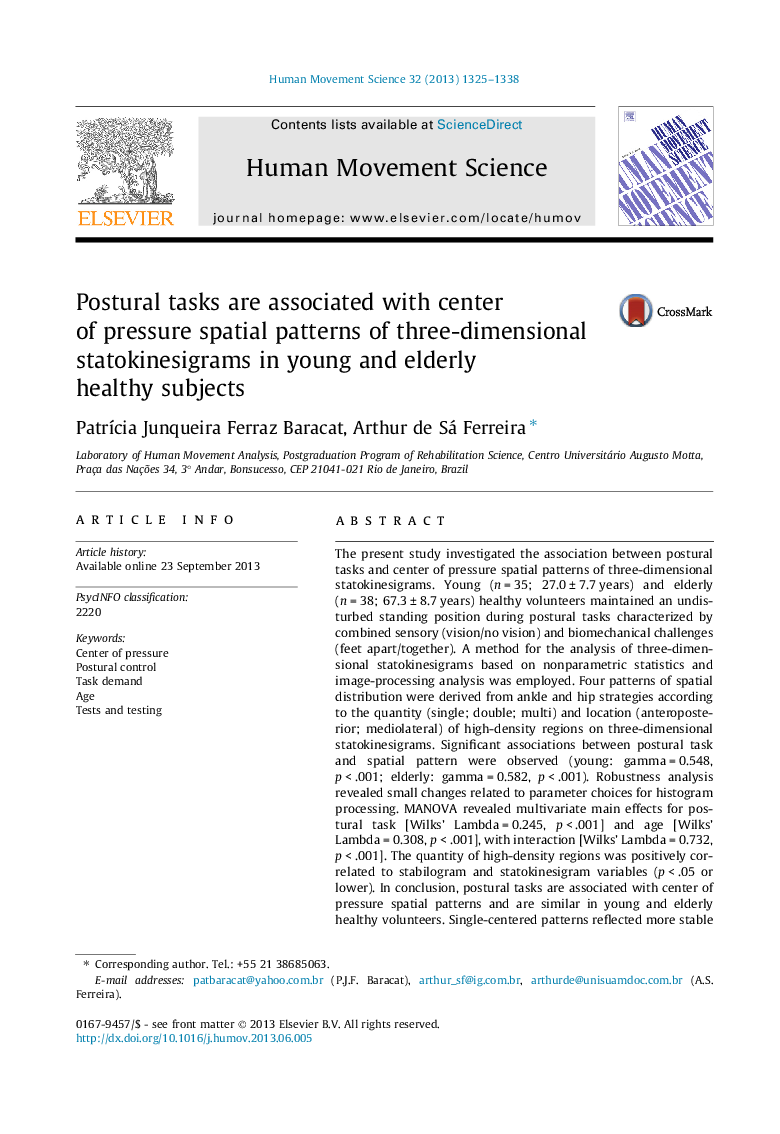| کد مقاله | کد نشریه | سال انتشار | مقاله انگلیسی | نسخه تمام متن |
|---|---|---|---|---|
| 10459147 | 922358 | 2013 | 14 صفحه PDF | دانلود رایگان |
عنوان انگلیسی مقاله ISI
Postural tasks are associated with center of pressure spatial patterns of three-dimensional statokinesigrams in young and elderly healthy subjects
ترجمه فارسی عنوان
وظایف پست در ارتباط با مرکز الگوهای فضایی فشار استاتوکینزگرام های سه بعدی در افراد سالم و سالم
دانلود مقاله + سفارش ترجمه
دانلود مقاله ISI انگلیسی
رایگان برای ایرانیان
کلمات کلیدی
2220، مرکز فشار، کنترل پستی تقاضای وظیفه، سن، آزمایش و آزمایش،
موضوعات مرتبط
علوم زیستی و بیوفناوری
علم عصب شناسی
علوم اعصاب شناختی
چکیده انگلیسی
The present study investigated the association between postural tasks and center of pressure spatial patterns of three-dimensional statokinesigrams. Young (n = 35; 27.0 ± 7.7 years) and elderly (n = 38; 67.3 ± 8.7 years) healthy volunteers maintained an undisturbed standing position during postural tasks characterized by combined sensory (vision/no vision) and biomechanical challenges (feet apart/together). A method for the analysis of three-dimensional statokinesigrams based on nonparametric statistics and image-processing analysis was employed. Four patterns of spatial distribution were derived from ankle and hip strategies according to the quantity (single; double; multi) and location (anteroposterior; mediolateral) of high-density regions on three-dimensional statokinesigrams. Significant associations between postural task and spatial pattern were observed (young: gamma = 0.548, p < .001; elderly: gamma = 0.582, p < .001). Robustness analysis revealed small changes related to parameter choices for histogram processing. MANOVA revealed multivariate main effects for postural task [Wilks' Lambda = 0.245, p < .001] and age [Wilks' Lambda = 0.308, p < .001], with interaction [Wilks' Lambda = 0.732, p < .001]. The quantity of high-density regions was positively correlated to stabilogram and statokinesigram variables (p < .05 or lower). In conclusion, postural tasks are associated with center of pressure spatial patterns and are similar in young and elderly healthy volunteers. Single-centered patterns reflected more stable postural conditions and were more frequent with complete visual input and a wide base of support.
ناشر
Database: Elsevier - ScienceDirect (ساینس دایرکت)
Journal: Human Movement Science - Volume 32, Issue 6, December 2013, Pages 1325-1338
Journal: Human Movement Science - Volume 32, Issue 6, December 2013, Pages 1325-1338
نویسندگان
PatrÃcia Junqueira Ferraz Baracat, Arthur de Sá Ferreira,
